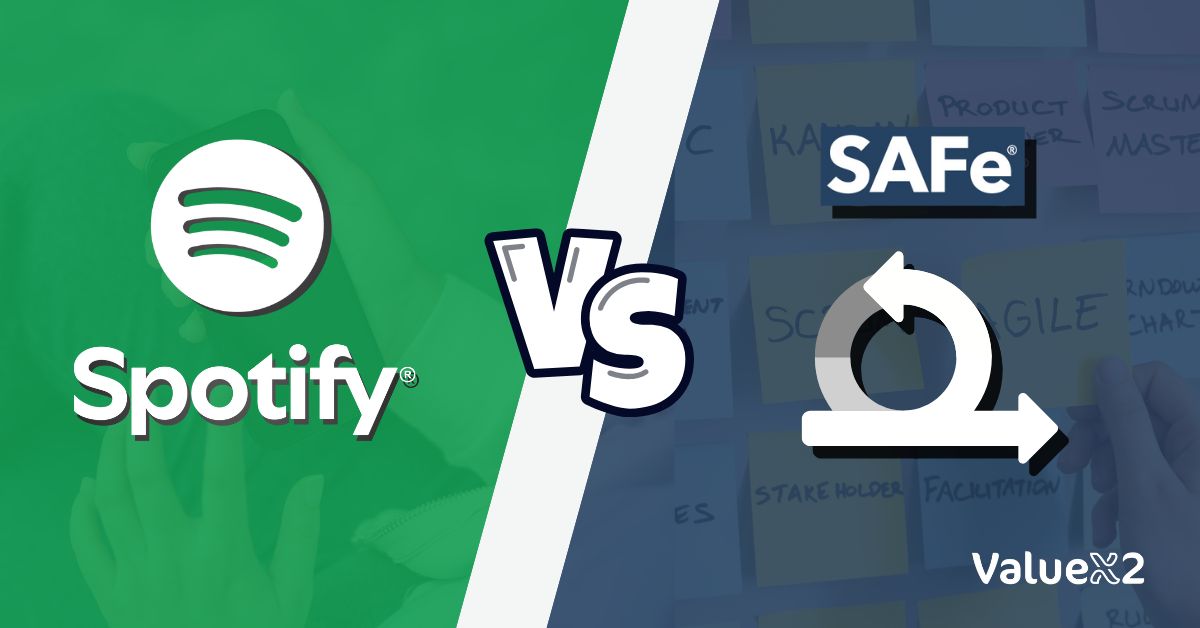Learn how the Spotify Model in Agile encourages innovation and adaptability and how SAFe brings order and synchronization where companies choose the best way to go for Agile at scale.

Introduction
In the modern world, it has become important for large companies to remain relevant, consistent, and fresh. To meet this need, Agile scaling frameworks facilitate the integration and delivery of Agile across complex structures. Of these frameworks, the Scaling Agile at Spotify or what people often call the Spotify Model in Agile has attracted much attention. SAFe (Scaled Agile Framework), on the other hand, has developed into a rigid and systematic way of scaling Agile.
This article helps to understand What is the Spotify Model, compares and contrasts the differences between the two methodologies SAFe and Spotify Model to identify the strengths and weaknesses of each. It is now time to understand how these two frameworks redefine the Agile at scale!
Overview of the Spotify Model in Agile
What is the Spotify Model in Agile?
The Spotify Model in Agile is an adaptable approach formulated by the Swedish music provider, Spotify, to deliver increased speed in innovation, self-organisation, and collaboration among teams. Referred to as the Spotify Model, this has been widely used as a framework for organisational scaling of Agile since about 2012. It is an open-minded approach that aims at achieving better results in terms of team efficiency and customers.
Key Structural Elements
The Spotify Model is built around specific structural elements designed to balance independence and collaboration:
- Squads: These are self-managed, temporary, and multi-membered units responsible for undertaking particular goals, such as creating a feature. Each of them works as a separate small startup which can make its own decisions and give outcomes.
- Tribes: A tribe is a group of squads based on working on similar projects. Tribes are meant to ensure that there is always teamwork, and all the squads see eye to eye. The usual maximum number of employees is around 100, to maintain intimate contact with the staff.
- Chapters: Chapters are formal subsets of the tribes that group people with the same specialities. For instance, all the designers irrespective of the squads that they may be part of be it product, content, brand or service design can form a design chapter to enhance skill and knowledge sharing.
- Guilds: Guilds allow the exchange of knowledge and assets around tasks and methodologies in a discipline, teams of practitioners, or areas of interest.
Key principles of the Spotify Model in Agile
The Spotify Model emphasises four key principles that guide its application:
- Autonomy: There are teams known as squads and mid-level management has the flexibility to coordinate themselves without interference from higher levels.
- Alignment: Although squads work separately from each other, they work towards a common goal of achieving a company’s vision and goal for continuity.
- Transparency: Transparency and public accountability make it possible for individuals and teams to document work outcomes, understand what others have done, and prevent repetition of any efforts.
- Rapid Learning: Ideas from field employees and subordinates are welcome since they encourage constant innovation and testing.
Overview of SAFe: Scaled Agile Framework
What is SAFe?
The Scaled Agile Framework (SAFe) is an effective model used in organisations for extending Agile solutions to different levels of an enterprise. It intends to provide better, more coherent integration across companies’ organisation, communication and cadence. SAFe is a combination of Agile, Lean, and DevOps.
It allows enterprises to deal with the challenges of Agile growth as well as provide customers with steady value. Due to the focus on organisational integration and program delivery, SAfe also helps organisations to respond to rapidly changing conditions and meet evolving needs.
Core Principles of SAFe
SAFe is built on several foundational principles that guide its implementation and success:
- Alignment: SAFe helps to align the entire organisation on multiple levels, specifically on a team, program, and portfolio level. This unbroken focus avoids compartments so all actions bear towards similar ends.
- Built-in Quality: Pursuing high quality is another fundamental concern of SAFe from design to delivery. Various applications like ‘test automation’ and “frequent reviews” are encouraged.
- Transparency: Transparency is central to the development of trust. Some of the work includes using Kanban boards, progress tracking, and meetings for feedback across the different teams and to stakeholders.
- Program Execution: The delivery of value to customers is the ultimate mark of success in a marketplace. Like all Agile approaches, SAFe relies on Agile Release Trains (ARTs) and maintains a firm schedule of program increments (PIs).
SAFe’s Structural Elements
- Agile Release Train (ART): The ART is deeply incorporated into SAFe and one of its keystone configurations. It indicates a set of Agile teams who are co-located with the intention of providing a consistent stream of value. Each ART fulfils the function of the “team of teams,” including the principle of synchronisation of planning.
- Program Increment (PI): A Program Increment is a time frame of 8-12 weeks in which the program and other involved teams define the scope, build, and fulfil valuable goals. Two of the key activities related to PI Planning are that this practice guarantees that all groups are aligned and understand the vision of all the teams, as well as have clearly defined priorities and goals.
- Value Streams: Value Streams are defined at the organisational level and are specifically designed to deliver ongoing value to customers. They prescribe the manner in which work is to flow from concept to delivery with the idea of focusing the resources where they will have the most effect.
- Portfolio Level: At the strategic level, Portfolio Level ensures that work being done by the organisation is in line with overall business objectives. Besides, it includes the identification of epics with large business initiatives, budget determination, and more.
Spotify vs SAFe: How Do They Differ?

| Aspect | Spotify Model in Agile | SAFe (Scaled Agile Framework) |
| Structure | Decentralised with free-flowing team structures like Squad, Chapter and Guild. | Centralised with a defined hierarchy similar to ARTs and Value Streams. |
| Focus | Focuses more on the team, modification and work culture. | Emphasises aims, goals, and objectives. |
| Governance | Low levels of governance; management is done by autonomous working groups. | Effective working relationships with good levels of accountability at both regional and national levels. |
| Scalability | Grows through informal collaboration and knowledge-sharing. | Grows through formalised frameworks and program increments. |
| Planning Approach | Continuous, adaptive planning with a focus on iteration. | Support and Continuous Delivery with fixed timeboxed increments for better PI planning. |
| Role of leadership | Managers occupy several roles at once to facilitate a process and empower their teams. | Management directs tasks to priorities and guarantees delivery. |
| Suitability | Most suitable for organisations with a high Agile maturity and creative environments. | Recommended for large-scale institutions to give a structure and regularity to their workplaces. |
| Value delivery | Sustained delivery of implemented ideas from the team. | Delivery integrated with organisational strategy and value streams. |
Spotify Model in Agile: Pros and Cons
| Pros | Cons |
|
|
SAFe (Scaling Agile Framework): Pros and Cons
| Pros | Cons |
|
|
Spotify Model in Agile vs SAFe: Which One Should You Choose?
The decision of which is better between the Spotify model in Agile and SAFe is that they both work well depending on the organisation’s objectives and the work culture. Each framework has its benefits, but its application is what decides which one may be preferred in an organisation.
The Spotify model in Agile is suitable for organisations that focus on decentralising their structures, enhancing creativity and flexibility and encouraging culture change. However, this model may not work well in large organisations where there are many dependencies because there isn’t much structure to the organisation’s governance.
Whereas, SAFe provides coherence of delivery with business goals and requirements. It is ideal for industries of a predictable nature as well as well-governed industries. Comparing SAFe vs. Spotify shows that SAFe is more organised. But, it can also be overly bureaucratic and may hinder creativity and foster decentralisation of decision-making too much at the same time.
Thus, the best approach to choose between the two frameworks is to analyse the objectives your company wants to achieve next. If flexibility, innovation and team autonomy are of essence then the Spotify model in Agile should be chosen. SAFe is preferable when it comes to alignment, scalability and immediate results.
Whether you embrace Scaling Agile at Spotify or adopt SAFe, always consider the importance of shared values that embrace collaboration, transparency, and learning orientation as key success factors for successful scaling.
Scale Your Career in Agile with ValueX2
At ValueX2, we offer professional courses recognized globally in order to equip those practising different professions. Whether you want certification in Agility in HR, marketing, project management or SAFe certifications our varied programs will keep you relevant in today’s ambitious world.
They are designed with the expertise of professional facilitators for applied settings where simple theory informs practice. ValueX2 offers you freedom and flexibility: online, classes, mentors and the most effective content to boost your career.
Turn your career around through the thousands who have enrolled at our institutions. Visit ValueX2 and discover our courses now to start your journey to success here!
Closing Comments
As the business environment continues to change, there is a need to learn how to scale Agile in order to support the competition, creativity, and operational excellence that organisations need.
Whether your organisation should adopt Spotify or SAFe depends on the organisation’s needs. If you aim to nurture creativity and support high-speed prototyping, then you may find the solution in the Spotify Model in Agile. If you require a framework that guarantees compliance, the ability to expand and a way to get a hold of it, then SAFe is a better choice.
When it comes to which framework to implement, it doesn’t matter, because the trick is in the atmosphere: collaboration, transparency, and, of course, the willingness to keep learning if Agile is to become a permanent and winning solution.
Frequently Asked Questions (FAQs)
Q. Is the Spotify Model suitable for large organisations?
Ans. In the Agile environment, the Spotify Model is as flexible and creative as the main product behind the site, which will suit a small innovative team. Still, in environments where dependencies are far-reaching and sophisticated, the benefit of decentralisation may be a challenge to its effectiveness in large companies.
Q. Which framework is better for innovation: Spotify Model or SAFe?
Ans. Spotify Model can be more effective for encouraging innovation since it is based on decentralised and team-generated concepts. Whereas structural execution, which is the primary model for SAFe, will slow innovation but will work in cooperation with the strategy.
Q. How difficult is it to implement SAFe in comparison to the Spotify Model?
Ans. Organising with SAFe may be even more difficult as it requires more radical structure change, extensive training, and commitment to specific frames. However, the Spotify Model in Agile is more flexible, but it is based on the understanding of culture.
Q. Can we combine the elements of the Spotify Model in Agile and SAFe?
Ans. Yes, adopting components from both frameworks within an organisation is possible. For example, adaptability as envisaged by the Spotify Model in the Agile approach may add the formality and rigidity offered by SAFe.
This means that, while adopting Scaling Agile at Spotify, the hybrid approach can maximise the benefits achieved by focusing on the right things while being strategically aligned at the same time.
Q. What is the role of leadership in the context of the Spotify Model?
Ans. In the Spotify Model in Agile, leadership deals with the idea of people, where implication means encouraging team ownership and collaboration.

Bhavna is an Agile Coach and Consultant with over a decade of experience in advisory, corporate finance, IT assurance, and operations at Big 4 and within the industry in the UK and India. She has recently been the CEO of a start-up where she implemented agile practices within HR, Marketing, and Product teams.
She is also a SAFe® Practice Consultant (SPC) and authorized instructor for ICAgile Agility in HR (ICP-AHR), Agility in Marketing (ICP-MKG), and Business Agility Foundations (ICP – BAF) training courses. She provides training for agile transformation to corporate, public, and private batches, as well as consulting for enterprise agile transformation.







Thanks for clarifying the information, I haven’t studied SAFe deeply, so I didn’t certainly know that I had applied both scaled frameworks in my previous job (hybrid approach). Your explanation is clear and concise. Great post!
We are so happy that you liked the content! Thank you!